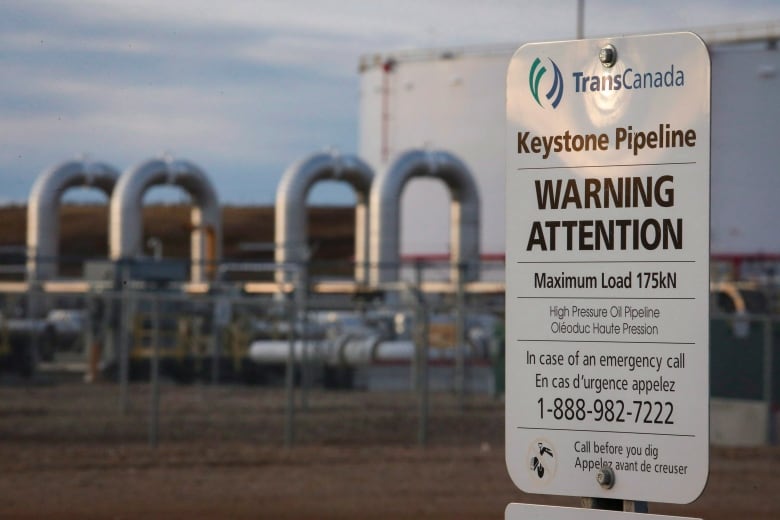U.S. Transportation Secretary Pete Buttigieg says it ordered a shutdown of the Keystone oil pipeline this week, after a leak of 14,000 barrels of crude oil was discovered in northeastern Kansas.
“We are monitoring & investigating the Keystone Pipeline leak first detected Weds night,” Buttigieg said on Twitter Friday, adding that the administration has issued a Correction Action Order “requiring a shutdown of the affected segment, analysis of the cause, and other safety measures.”
The pipeline’s Canadian owner, TSX-listed TC Energy, had previously acknowledged the pipeline was shut down, but Friday’s announcement was the first suggestion that it there was a formal request to do so from government.
The leak is the largest in the history of the pipeline, which carries more than 600,000 barrels of crude oil per day from Alberta to refineries on the U.S. Gulf Coast. About one fifth of all the crude oil that Canada exports to the U.S. every day goes along the pipeline.
On Wednesday evening oil started spilling into a creek near the pipeline in Washington County, Kan., about 240 kilometres northwest of Kansas City.
The company says the affected pipeline segment had been “isolated” and the oil contained at the site with booms, or barriers. No explanation for what caused the spill was given.
Among the largest spills ever
The amount of oil spilled has been estimated at 14,000 barrels, making it larger than all of the 22 previous spills combined on the Keystone pipeline since it was opened in 2010, according to Zack Pistora, a lobbyist for the Sierra Club in Kansas.
“This is going to be months, maybe even years before we get the full handle on this disaster and know the extent of the damage and get it all cleaned up,” he said.
In September 2013, a Tesoro Corp. pipeline in North Dakota ruptured and spilled 20,600 barrels, according to U.S. Department of Transportation data. The company, which worked to recover oil for years but only recovered a fraction of the spill, said that a lightning strike may have caused that break.
A more expensive spill happened in July 2010, when an Enbridge Inc. pipeline in Michigan ruptured and spilled more than 20,000 barrels into Talmadge Creek and the Kalamazoo River. Hundreds of homes and businesses were evacuated and federal regulators later ordered Enbridge to dredge the contaminated sediment from the river.
The Keystone pipeline’s previous largest spill came in 2017, when more than 6,500 barrels were spilled near Amherst, S.D.,, according to a U.S. Government Accountability Office report released last year. The second largest happened in 2019 near Edinburg, N.D., when it leaked 4,515 barrels.
No evacuations ordered
The U.S. Environmental Protection Agency said there were no known effects yet on drinking water wells or the public in connection with this week’s spill, and the oil didn’t move from the creek to larger waterways. No evacuations were ordered because the break occurred in rural pastureland, according to Randy Hubbard, the Washington County Emergency Management coordinator.
TC Energy said it had set up environmental monitoring at the site, including around-the-clock air quality monitoring.
“Our primary focus right now is the health and safety of onsite staff and personnel, the surrounding community, and mitigating risk to the environment,” a company statement said.
Junior Roop, the sexton of a cemetery near the spill site, said people could smell the oil in town.
“It was like driving by a refinery,” he said.
Concerns that spills could pollute waterways spurred opposition to plans by TC Energy to build another crude oil pipeline in the Keystone system, the 1,900-kilometre Keystone XL, which would have cut across Montana, South Dakota and Nebraska.
Critics also argued that using crude from Western Canada’s oil sands would worsen climate change, and President Joe Biden’s cancellation of a U.S. permit for the project led the company to pull the plug last year.
Local reaction
Paul Stewart, an area farmer, said part of it was contained on his land using yellow booms and a dam of dirt. The spill occurred in Mill Creek, which flows into the Little Blue River.
The Little Blue feeds the Big Blue River, which flows into Tuttle Creek Lake, north of Manhattan, home of Kansas State University. The EPA said the oil did not affect the Little Blue.
Chris Pannbacker said the pipeline runs through her family’s farm. She and her husband drove north of their farmhouse and across a bridge over Mill Creek.
“We looked at it from both sides, and it was black on both sides,” said Pannbacker, a reporter for the Marysville Advocate newspaper.


